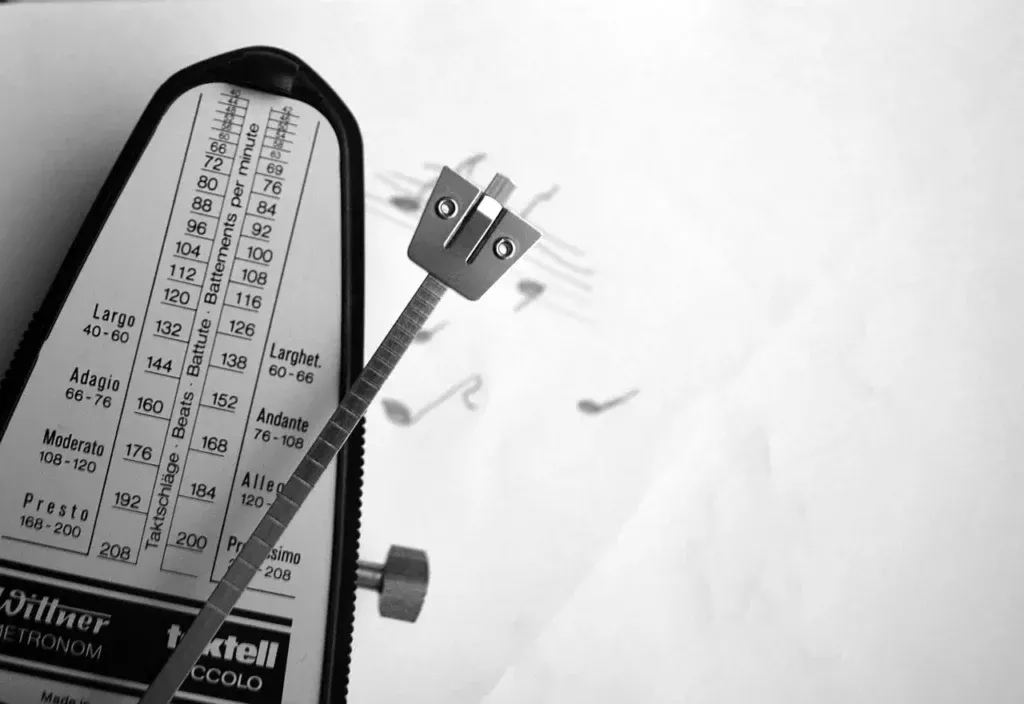by Guitar Tricks.

Playing the guitar is not just about mastering chords, scales, and flashy techniques. It’s also about timing and rhythm. Whether you’re jamming with a band or performing solo, your sense of rhythm is the glue that binds your music together. One invaluable tool in developing this essential skill is the metronome, a beginner guitarist’s best friend. We’re going to explore how practicing with a metronome can elevate your rhythmic accuracy and control, and we’ll guide you through a step-by-step process of progressively removing beats to enhance your sense of timing.
Step 1: Set Up Your Metronome
Before we delve into the intricacies of rhythm, you need to set up your metronome. You can use a physical metronome or a metronome app on your smartphone or computer. The key features to look for are the ability to adjust the beats per minute (BPM) and the option to mute specific beats. Personally, I like to use the “Tempo” app, and that’s what I’ll be using in the video tutorial.
Step 2: Start with Steady Quarter Notes
Now that your metronome is ready, it’s time to get started. Begin by setting the metronome to a comfortable tempo, such as 90 BPM, in a 4/4 meter. This tempo will serve as our foundation. Your task is to play a simple chord progression, riff, or scale pattern using steady quarter notes. The goal here is to ensure that each note you play aligns precisely with the metronome click.
This step might seem elementary, but it’s crucial to establish a strong connection between your playing and the metronome’s beat. It’s the foundation upon which we’ll build our sense of timing.
Step 3: Removing Beats 2 and 4
Once you feel comfortable playing along with the metronome on all four beats, it’s time to up the challenge. Remove the second and fourth beats from your metronome clicks. This means you’ll now only receive half of the information from the metronome, and it’s up to you to audiate (hear in your head) the missing beats.
This exercise is a fantastic way to develop a robust internal sense of timing and groove. It forces you to rely less on external cues and more on your innate musical intuition.
Step 4: Leave Only Beat 1
As you become adept at playing with only the first and third beats of the metronome, it’s time to take things a step further. Remove the third beat as well, so that you’re left with only the downbeat of each measure. Before you start playing, take a moment to listen and audiate the missing beats. Count yourself off, and then play along.
You’ll quickly discover that you have to calibrate from measure to measure to ensure your notes line up precisely with the metronome’s downbeat. With practice, this calibration becomes more natural, and your internal sense of timing becomes increasingly reliable.
Step 5: Halving the Tempo
Once you’ve mastered the art of playing with only the downbeat of the measure, it’s time to push your rhythmic control even further. Halve the metronome’s tempo to a challenging 45 BPM. This means you’ll now isolate the downbeat of every other measure.
Be prepared for a significant challenge. Take a moment to feel out the rhythm internally before you start playing. You’ll find yourself continually calibrating your playing to lock into the metronome’s slow, deliberate clicks. As you progress, you might be tempted to use your body’s movement to help you stay in time, which is a valuable skill. However, also challenge yourself to rely entirely on your internal sense of rhythm. This exercise will solidify your internal pulse and rhythmic control like nothing else.
Conclusion: Elevating Your Rhythmic Precision
Practicing with a metronome and progressively removing beats is a powerful method to enhance your rhythmic accuracy and control on the guitar. By gradually reducing your reliance on external cues, you develop a robust internal sense of timing. This internal timing is crucial for enhancing your musicality and musicianship.
Remember that consistency and patience are the keys to success with this technique. Don’t rush the process. Enjoy the journey of refining your sense of timing, and appreciate how it elevates your playing to new heights.
So, grab your metronome, set your tempo, and dive into this rhythmic challenge with enthusiasm. As you progressively remove beats and strengthen your internal rhythm, you’ll find that your musicality soars, and your ability to groove with others becomes second nature. Keep practicing, keep listening, and keep enjoying the wonderful world of rhythm on the guitar.
